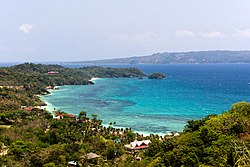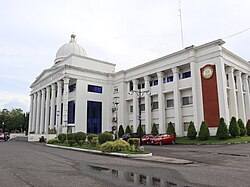Aklan | |
|---|---|
(from top: left to right) Boracay Island, Kalibo Cathedral, Ati-atihan Festival, Aklan Museum, Kalibo Bakhawan Eco Park, and Aklan Provincial Capitol. | |
| Motto(s): "Arangkada, Aklan" | |
| Anthem: "Aklan Hymn" | |
 Location in the Philippines | |
| Coordinates: 11°40′N 122°20′E / 11.67°N 122.33°E | |
| Country | Philippines |
| Region | Western Visayas |
| First settled | 13th century |
| Founded | 25 April 1956 |
| Capital and largest municipality | Kalibo |
| Government | |
| • Governor | Jose Enrique M. Miraflores (Lakas) |
| • Vice Governor | Reynaldo M. Quimpo (Lakas) |
| • Legislature | Aklan Provincial Board |
| Area | |
| • Total | 1,821.42 km2 (703.25 sq mi) |
| • Rank | 64th out of 81 |
| Highest elevation | 1,777 m (5,830 ft) |
| Population (2020 census)[2] | |
| • Total | 615,475 |
| • Rank | 51st out of 81 |
| • Density | 340/km2 (880/sq mi) |
| • Rank | 23rd out of 81 |
| Demonym | Aklanon |
| Divisions | |
| • Independent cities | 0 |
| • Component cities | 0 |
| • Municipalities | |
| • Barangays | 327 |
| • Districts | Legislative districts of Aklan |
| Time zone | UTC+8 (PHT) |
| ZIP Code | 5600–5616 |
| IDD : area code | +63 (0)36 |
| ISO 3166 code | PH-AKL |
| HDI | |
| HDI rank | 29th in Philippines (2019) |
| Spoken languages | |
| GDP (2022) | ₱63.57 billion $1.084 billion [3] |
| Growth rate | |
| Website | aklan |
Aklan, officially the Province of Aklan (Akeanon: Probinsya it Akean [ak'ɤan]; Hiligaynon: Kapuoran sang Aklan; Tagalog: Lalawigan ng Aklan), is a province in the Western Visayas region of the Philippines. Its capital and largest town is Kalibo. The province is situated in the northwest portion of Panay Island, bordering Antique to the southwest, and Capiz to the southeast. Aklan faces the Sibuyan Sea and Romblon province to the north.
Aklan is most well-known for Boracay, a resort island 0.8 kilometer north of the tip of Panay. It is known for its white sand beaches and is considered one of the more prominent destinations in the country. The Ati-Atihan Festival of Kalibo has also been known worldwide, hence declared "The Mother of all Philippine Festivals." It is an annual celebration held on the third Sunday of January to honor the Santo Niño (Infant Jesus). The festival showcases tribal dancing through the town's main streets to the tune of ethnic music, with participants in indigenous costumes and gear.[4]
- ^ "List of Provinces". PSGC Interactive. Makati City, Philippines: National Statistical Coordination Board. Archived from the original on 19 April 2016. Retrieved 14 May 2014.
- ^ Census of Population (2020). "Region VI (Western Visayas)". Total Population by Province, City, Municipality and Barangay. Philippine Statistics Authority. Retrieved 8 July 2021.
- ^ "2021 to 2023 Gross Regional Domestic Product (GRDP)". openstat.psa.gov.ph. Philippine Statistics Authority. Retrieved April 26, 2024.
- ^ "Invest in Aklan | The Official Website of Aklan Province". Retrieved 2022-07-27.
 This article incorporates text from this source, which is in the public domain.
This article incorporates text from this source, which is in the public domain.








